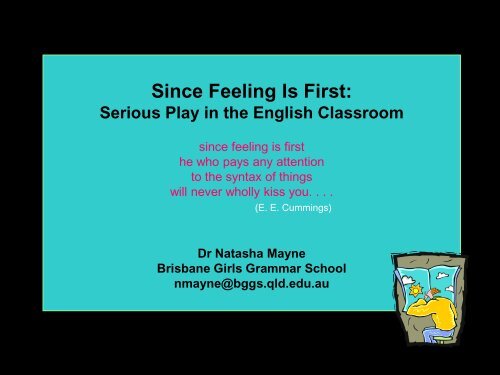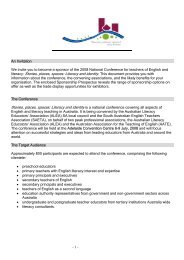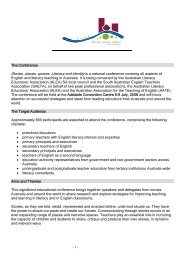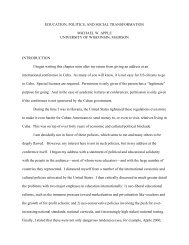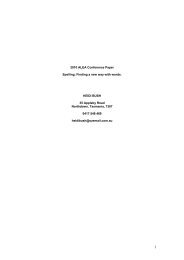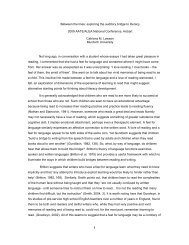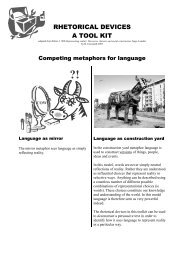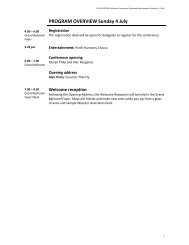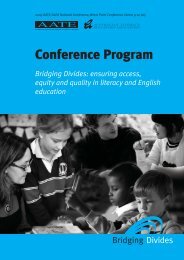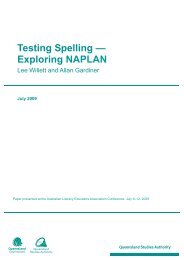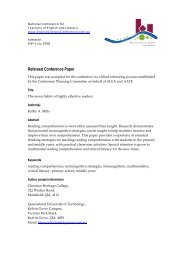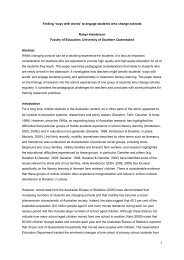Since Feeling Is First:
Since Feeling Is First:
Since Feeling Is First:
Create successful ePaper yourself
Turn your PDF publications into a flip-book with our unique Google optimized e-Paper software.
<strong>Since</strong> <strong>Feeling</strong> <strong>Is</strong> <strong>First</strong>:<br />
Serious Play in the English Classroom<br />
since feeling is first<br />
he who pays any attention<br />
to the syntax of things<br />
will never wholly kiss you. . . .<br />
(E. E. Cummings)<br />
Dr Natasha Mayne<br />
Brisbane Girls Grammar School<br />
nmayne@bggs.qld.edu.au
“Emotion and feeling lie at the heart of our<br />
capacity to experience meaning.”<br />
(Johnson 2007, p. 53)<br />
The aesthetic is foundational to narrative<br />
and to subject English.
Defining the Aesthetic<br />
―The term refers not in the first place to art, but, as the<br />
Greek aisthesis would suggest to the whole region of<br />
perception and sensation.‖<br />
(Eagleton 1991, p. 13)<br />
It is ―the study of everything that goes into the human<br />
capacity to make and experience meaning.‖<br />
(Johnson 2007, p. x)<br />
The aesthetic is a way of knowing.
The aesthetic:<br />
a definition for the English<br />
classroom<br />
The aesthetic encompasses a wide range of emotional and critical responses<br />
to texts; indeed, the affective and the intellectual are considered to be<br />
intrinsically linked.<br />
It is far more than that which is simply “beautiful” in a text.<br />
It is ideology that we feel.
Aesthetic Textual Features<br />
Aesthetic textual features refer to those aspects of<br />
texts which prompt critical and emotional reactions.<br />
As such, the aesthetic is closely tied to reader and<br />
audience positioning.
Windows into Other Worlds:<br />
Why the aesthetic is so important<br />
―Classrooms don’t just produce assessable<br />
products, they are also the sites where students’<br />
subjectivities are shaped and re-shaped.‖<br />
(Morgan & Misson 2006, p. 210)
Aesthetic activities for<br />
the English classroom<br />
Real Reflection<br />
Jack Thomson’s Reading Journal prompts:<br />
•What did you bring to the reading of the novel that influenced/ helped/ hindered your<br />
reading<br />
•What would you have liked to have in your repertoire that would have helped you to read it<br />
better<br />
This was further broken down into the following response/repertoire categories:<br />
Personal experience;<br />
•Cultural knowledge;<br />
•Literary knowledge, general: how fiction works;<br />
•Literary knowledge, specific: how any particular texts you’ve read helped<br />
you to read this one;<br />
•Your beliefs or ideology.<br />
(Thomson 2009, p. 268
Aesthetic activities for<br />
the English classroom<br />
Ask…<br />
This is what I found out from my Year 12 students when I asked them the following questions<br />
at the start of an elective novel unit:<br />
Ways that studying novels at school can diminish your enjoyment of literature:<br />
•Reducing a book to a couple of themes/ideas when you know that there is so much more to<br />
the novel;<br />
•Analysis can kill emotional engagement;<br />
•Analysis can diminish imaginative engagement—feel you’ve solved the main mysteries of the<br />
novel, nothing left for your imagination to do;<br />
•Being forced to read something doesn’t set you up for enjoying novels;<br />
•Your ideas are ultimately assessed.<br />
Ways that studying novels at school can increase your enjoyment of literature:<br />
•Get valuable contextual info<br />
•Sense that other people enjoy the same things as you<br />
•Might discover novels that you wouldn’t read ordinarily<br />
•Learn more about very important issues
Aesthetic activities for<br />
the English classroom<br />
They asked for…<br />
•a Book Club session for the first 10 minutes of the first<br />
lesson of every week<br />
•textual intervention activities—they said they enjoyed<br />
writing from different characters’ points-of-view<br />
•opportunities to reflect on their own responses to the novel
Aesthetic activities for<br />
the English classroom<br />
contd<br />
•Student generated questions/ themes/ lines of inquiry<br />
•Gripping Moments<br />
Students were invited to share with the class a section of the<br />
novel that had moved them in some way.<br />
Some students chose the same sections as other students to comment<br />
upon, but they generally had slightly different interpretations and<br />
experiences of these textual moments.
Aesthetic activities for<br />
the English classroom:<br />
Embodied Enactment<br />
Feel It!<br />
•Enactment: Embodied Semantics<br />
link to The Searchers script/ acting activity used in my Yr 10 Western Elective Film unit.<br />
Students are divided into groups and each group is given a scene. Groups have to determine how to<br />
block the scene and deliver lines etc. They present (act out their scene) at the end of the lesson and<br />
explain why they made the choices they did.<br />
Later in the unit, they will continue working in their groups to storyboard their scene (a great way to learn<br />
and apply knowledge of film techniques) which they then edit it into a mock animated Western scene<br />
using PhotoShop and MovieMaker.
Sensory Maps: What do you see, touch, taste, smell, feel (emotionally)<br />
when you read this poem (student led activity using eBoard)
•Digital Stories and vlogs<br />
Aesthetic activities for<br />
the English classroom<br />
Digital Design<br />
See it<br />
•Page to Screen: Storyboards and Mini Movies.<br />
•Examples 1 –click through PPt slides (Mr March becomes smitten with Marmee) and<br />
2 (Mr March’s attempts to teach the plantation slaves to read and write—a crime—are<br />
discovered)<br />
In these activities, groups were given a scene from the novel March (our<br />
class study novel for term III 2008) and were asked to storyboard their<br />
scene and then edit it in PhotoShop and MovieMaker. This activity was<br />
conducted after assessment at the end of term and helped to prepare<br />
girls for their elective film unit in the following term.<br />
•Example 3 is the Western storyboarding activity referred to earlier.
Stanza to Screen:<br />
If your poem were to be filmed, what would we<br />
see,<br />
hear,<br />
feel
The Australian Curriculum<br />
Some Concerns<br />
Many of the delegates at the ACARA Literature<br />
Course feedback workshop called for revisions to<br />
be made to the curriculum to more appropriately<br />
reflect an holistic approach to texts and the<br />
teaching of English.
The Australian Curriculum<br />
Some Concerns<br />
Meaning is created in texts through an interplay of all four of<br />
the unit dimensions: language, texts and contexts;<br />
representations; intertextuality: perspectives, and more to<br />
boot!<br />
The problem with a compartmentalised approach to texts:<br />
It is impossible, for example, to consider how<br />
representations work in texts without also considering the<br />
impact of language, texts and contexts, intertextuality and<br />
perspectives etc at the same time. Likewise, (Lit) Unit 1’s<br />
focus on identifying, explaining and analysing nuances,<br />
allusions, paradoxes and ambiguities in texts is impossible<br />
to achieve by looking at language and context alone.
The Australian Curriculum and the Aesthetic<br />
There is some promising stuff in the draft curriculum; but, just as textual<br />
meaning is dependent on the complex interplay of many things, so too aesthetic<br />
engagement is dependent on a complex interplay of personal, experiential and<br />
textual elements.<br />
The aesthetic needs to be treated here in a more<br />
coherent and holistic manner as it is foundational to<br />
all that we do in English.
Works Consulted<br />
• ACARA (2009). The Shape of the Australian Curriculum.<br />
http://www.australiancurriculum.edu.au/Home<br />
• - - -. (2010). Draft K-12 Australian Curriculum in English.<br />
http://www.australiancurriculum.edu.au/Home<br />
• Arnold, R. & Hughes, J. (2009). “Empathy, Imagination and<br />
Creativity in English and Drama” in Manuel et al (2009), pp. 195-<br />
207.<br />
• Brock, P. (2009). “The Value of Literature and Language in<br />
Contemporary Education: A Personal Perspective” in Manuel et al<br />
(2009), pp. 23-40.<br />
• Campbell, R. (2009). “Evaluation of the English senior syllabus<br />
(2008) in open trial 2009 and 2010.” Interim Report submitted to the<br />
Queensland Studies Authority, October 2009.
Works Consulted contd<br />
• Eagleton, T. (1991). The Ideology of the Aesthetic. Massachusetts:<br />
Basil Blackwell Inc.<br />
• Gleeson, L. (2009). “Imagination, Innovation, Creativity: Re-Visioning<br />
English in Education” in Manuel et al (2009), pp. 139-144.<br />
• Iacobini, M. (2008). Mirroring People: The New Science of How We<br />
Connect With Others. NY: Farrar, Strauss & Giroux.<br />
• Johnson, M. (2007). The Meaning of the Body: Aesthetics of Human<br />
Understanding. Chicago: U of Chicago P.<br />
• Locke, T. (2009). “The Disappearance of Enjoyment: How Literature<br />
Went Wandering in the Literacy Woods and Got Lost” in Manuel et<br />
al (2009), pp. 123-138.<br />
• Manuel, J. (2009). “ „The Best Moments:‟ Adolescents‟ Reading<br />
Practices and Preferences” in Manuel et al (2009), pp. 99-122.<br />
• Manuel, J. Brock, P., Carter, D. & Sawyer, W. (eds) (2009).<br />
Imagination, Innovation, Creativity: Re-Visioning English in Education.<br />
NSW, Australia: Phoenix Education Pty Ltd.
Works Consulted contd<br />
• Marshall, B. (2009). “Goals or Horizons The Conundrum of Progression in<br />
English or a Possible Way of Understanding Formative Assessment in the<br />
English Classroom” in Manuel et al (2009), pp. 279-290.<br />
• Misson, R. and Morgan, W. (2006). Critical Literacy and the Aesthetic:<br />
Transforming the English Classroom. Illinois: National Council of<br />
Teachers of English.<br />
• Morgan, W. (2007). “Beyond gaps and silences: strategies for „doing‟ a<br />
critical aesthetic.” Words’Worth Vol 40, No 4, 16-21.<br />
• - - -. (2008). “Accounting for the Aesthetic.” Words’Worth Vol 41, No 1,<br />
54-57.<br />
• Oatley, K. (2008). Interview with scientist by Ramona Koval, Australian<br />
Broadcasting Corporation The Book Show radio program, 4 July<br />
2008.<br />
• ---. (2008). “The Science of Fiction: a good novel is far more than<br />
entertainment.” New Scientist 28 June, pp. 42-3.
Works Consulted contd<br />
• Pope, R. (1995). Textual intervention: Critical and creative strategies for<br />
literary studies. London: Routledge.<br />
• Sawyer, W. (2009). “Language and Literature: Revisiting Some<br />
Definining Moments in the History of English” in Manuel et al (2009), pp.<br />
71-86.<br />
• Thomson, J. (1987). Understanding Teenagers’ Reading: Reading<br />
Processes and the Teaching of Literature. Sydney: Methuen; London:<br />
Croom Helm; NY: Nichols.<br />
• - - -. (2009). “Texts, Repertoires and Reading Journals: How Knowing<br />
What They Know Helps Readers Read” in Manuel et al (2009), pp. 261-<br />
277.<br />
• Woolfe, S. (2007). The Mystery of the Cleaning Lady: a writer looks at<br />
creativity and neuroscience. WA: UWA P.


